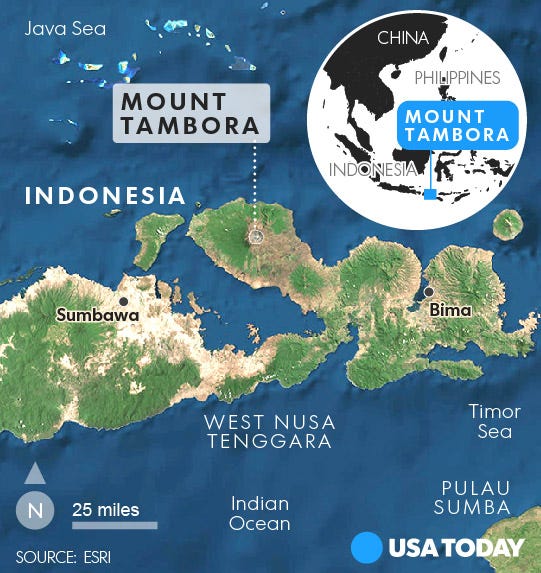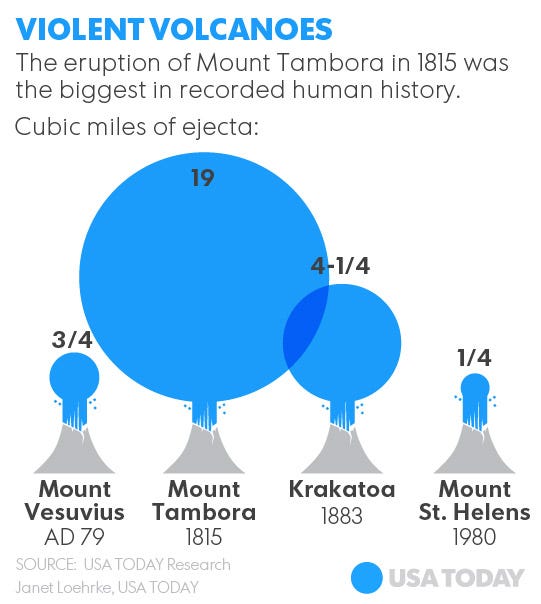Snow in June, freezing temperatures in July, a killer frost in August: "The most gloomy and extraordinary weather ever seen," according to one Vermont farmer.
Two centuries ago, 1816 became the year without a summer for millions of people in parts of North America and Europe, leading to failed crops and near-famine conditions.
While they didn't know the chill's cause at the time, scientists and historians now know that the biggest volcanic eruption in human history, on the other side of the world — Mount Tambora in Indonesia in April 1815 — spewed millions of tons of dust, ash and sulfur dioxide into the atmosphere, temporarily changing the world's climate and dropping global temperatures by as much as 3 degrees.
In addition to food shortages, the natural climate change caused disease outbreaks, widespread migration of people looking for a better home and religious revivals as people tried to make sense of it all.
The gloom spread to the literary world, too: that foul, frigid year inspired the plot of Mary Shelly's epic horror novel Frankenstein.
And it could happen again. Big volcanoes can erupt at anytime and with little warning, potentially changing the climate and giving a temporary reprieve to man-made global warming.
"We cannot reliably predict exactly when a volcano will erupt, or how powerful it will be, until the eruption is nearly upon us," said Nicholas P. Klingaman, co-author of the book The Year without Summer.
A volcano erupts
The eruption of Tambora, on April 10, 1815, on the island of Sumbawa in what's now Indonesia, was 100 times more powerful than the 1980 Mount St. Helens blast, according to the U.S. Geological Survey, which ranked the eruption as a seven on its eight-level volcanic explosivity index.The volcano spewed out enough ash and pumice to cover a square area 100 miles on each side to a depth of almost 12 feet, according to the book, The Year without Summer, by Klingaman and his father, William K. Klingaman.
It was by far the deadliest volcanic eruption in human history, the Klingamans wrote, with a death toll of at least 71,000 people, up to 12,000 of whom killed directly by the eruption, according to the journal Progress in Physical Geography.
When a volcano erupts, it does more than spew clouds of ash, which can cool a region for a few days and disrupt airline travel. It also spews sulfur dioxide, NASA reports.
Because these aerosols float above the altitude of rain, they don't get washed out. Instead they linger, reflecting sunlight and cooling the Earth's surface, which is what caused the weather and climate impacts of Tambora's eruption to occur more than a year later.
Miserable summer
Heavy snow fell in northern New England on June 7-8, with 18- to 20-inch high drifts. In Philadelphia, the ice was so bad "every green herb was killed and vegetables of every description very much injured," according to the book American Weather Stories.Frozen birds dropped dead in the streets of Montreal, and lambs died from exposure in Vermont, the New England Historical Society said.
On July 4, one observer wrote that "several men were pitching quoits (a game) in the middle of the day with heavy overcoats on." A frost in Maine that month killed beans, cucumbers and squash, according to meteorologist Keith Heidorn. Ice covered lakes and rivers as far south as Pennsylvania, according to the Weather Underground.
By the time August rolled around, more severe frosts further damaged or killed crops in New England. People reportedly ate raccoons and pigeons for food, the New England Historical Society said.
Europe also suffered mightily: the cold and wet summer led to famine, food riots, the transformation of stable communities into wandering beggars and one of the worst typhus epidemics in history, according to The Year without Summer.
Scientists’ best estimate is that the global-average temperature cooled by almost 2 degrees in 1816 said Nicholas Klingaman, who is also a meteorologist at the University of Reading in the United Kingdom. Land temperatures cooled by about 3 degrees, he added.
How soon could it happen again?
Eruptions on the scale of Tambora occur once every 1,000 years on average, but smaller events can still substantially impact the climate, Klingaman said. Krakatoa's 1883 eruption in Indonesia caused global cooling nearly five years later, even though it ejected less material into the atmosphere than Tambora.Similarly, Pinatubo in 1991 in the Philippines caused global temperatures to cool by about 1 degree, Klingaman said. Eruptions of that magnitude — about one-sixth the size of the Tambora eruption — happen about once every 100 years.
"Any of those other volcanoes could erupt again, perhaps on a scale of Tambora or greater," said Mike Mills, an atmospheric chemist at the National Center for Atmospheric Research in Boulder, Colo.
The subject of how volcanoes affect climate is relatively new: Scientists didn't confirm the link between volcanic eruptions and global cooling until the 1960s and 1970s, Klingaman said.
A new area of research delves into how volcanic eruptions could interact with global warming, Mills said. The chemist says his own investigation found the role of volcano eruption in global climate change could be underestimated. And it could help explain why global warming appeared to temporarily slow down early this century when volcanic activity increased.
With global temperatures at record highs, a massive eruption today could halt man-made climate change. But the effect would be only temporary: Warming would pick up where it left off once all the stratospheric dust settled out, a process that could a few years or up to a decade, Weather Underground reported.
The fallout on the people affected by the event, though, could last far longer. The colorful, dusty skies from Tambora's epic blast inspired some of British artist J. M. W. Turner's most spectacular sunset paintings — some of which were painted decades after the eruption.
Please share this.


No comments:
Post a Comment